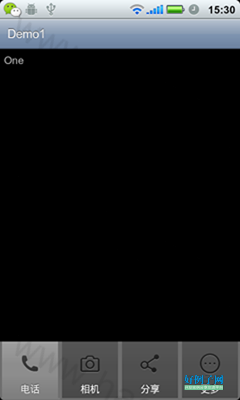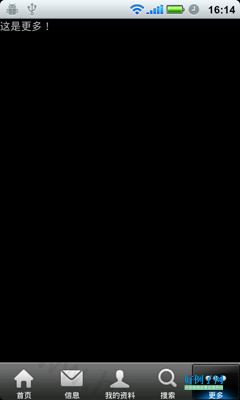Android底部菜单栏的两种实现方式 附完整源码
原创:http://www.haolizi.net/example/view_447.html
【实例简介】
【实例截图】
通过TabWidget实现

实现方式二:隐藏TabWidget,通过RadioGroup和RadioButton实现底部菜单栏

【核心代码】
实现方式一:通过TabWidget实现
这种方式主要是在布局中将TabWidget标签嵌套在RelativeLayout中,并且在TabWidget标签中中设置 android:layout_alignParentBottom="true"
另外,下划线和选项卡之间的线去除的方法时在TabWidget标签中设置属性android:tabStripEnabled="false"
xml:
|
1
2
3
4
5
6
7
8
9
10
11
12
13
14
15
16
17
18
19
20
21
22
23
24
25
26
27
28
29
30
|
<?xml version="1.0" encoding="utf-8"?> android:id="@android:id/tabhost" android:layout_width="fill_parent" android:layout_height="fill_parent" android:orientation="vertical" > <FrameLayout android:id="@android:id/tabcontent" android:layout_width="fill_parent" android:layout_height="fill_parent" android:padding="5dp" ></FrameLayout> <RelativeLayout android:layout_width="fill_parent" android:layout_height="fill_parent"> <!-- tabStripEnabled属性去掉底部下划线与选项卡间的下划线 --> <!-- layout_alignParentBottom属性即可将其放在底部菜单栏,注意,必须在RelativeLayout里 --> <TabWidget android:id="@android:id/tabs" android:tabStripEnabled="false" android:background="#6E6E6E" android:layout_width="fill_parent" android:layout_height="wrap_content" android:layout_alignParentBottom="true" ></TabWidget> </RelativeLayout></TabHost> |
实现代码如下
|
1
2
3
4
5
6
7
8
9
10
11
12
13
14
15
16
17
18
19
20
21
22
23
24
25
26
27
28
29
30
31
32
33
34
35
36
37
38
|
package com.loulijun.demo1;import android.app.TabActivity;import android.content.Intent;import android.os.Bundle;import android.widget.TabHost;public class Demo1Activity extends TabActivity { /** Called when the activity is first created. */ private TabHost tabhost; private Intent intent1, intent2, intent3, intent4; @Override public void onCreate(Bundle savedInstanceState) { super.onCreate(savedInstanceState); setContentView(R.layout.main); tabhost = getTabHost(); intent1 = new Intent(Demo1Activity.this, One.class); tabhost.addTab(tabhost.newTabSpec("one") .setIndicator("电话",getResources().getDrawable(android.R.drawable.ic_menu_call)) .setContent(intent1)); intent2 = new Intent(Demo1Activity.this, Two.class); tabhost.addTab(tabhost.newTabSpec("two") .setIndicator("相机",getResources().getDrawable(android.R.drawable.ic_menu_camera)) .setContent(intent2)); intent3 = new Intent(Demo1Activity.this, Three.class); tabhost.addTab(tabhost.newTabSpec("three") .setIndicator("分享",getResources().getDrawable(android.R.drawable.ic_menu_share)) .setContent(intent3)); intent4 = new Intent(Demo1Activity.this, Four.class); tabhost.addTab(tabhost.newTabSpec("four") .setIndicator("更多",getResources().getDrawable(android.R.drawable.ic_menu_more)) .setContent(intent4)); }} |
实现方式二:隐藏TabWidget,通过RadioGroup和RadioButton实现底部菜单栏
这种方式更漂亮,也更灵活,网上基本用的是这种方式,通过setCurrentTabByTag来切换不同的选项卡
main.xml:
|
1
2
3
4
5
6
7
8
9
10
11
12
13
14
15
16
17
18
19
20
21
22
23
24
25
26
27
28
29
30
31
32
33
34
35
36
37
38
39
40
41
42
43
44
45
46
47
48
49
50
51
52
53
54
55
56
57
58
59
60
61
62
|
<?xml version="1.0" encoding="utf-8"?> android:id="@android:id/tabhost" android:layout_width="fill_parent" android:layout_height="fill_parent" > <LinearLayout android:orientation="vertical" android:layout_width="fill_parent" android:layout_height="fill_parent"> <FrameLayout android:id="@android:id/tabcontent" android:layout_width="fill_parent" android:layout_height="0.0dip" android:layout_weight="1.0"/> <TabWidget android:id="@android:id/tabs" android:layout_width="fill_parent" android:layout_height="wrap_content" android:layout_weight="0.0" android:visibility="gone"/> <RadioGroup android:id="@ id/main_tab" android:background="@drawable/maintab_toolbar_bg" android:orientation="horizontal" android:layout_width="fill_parent" android:layout_height="wrap_content" android:gravity="center_vertical" android:layout_gravity="bottom"> <RadioButton android:layout_marginTop="2.0dip" android:text="@string/main_home" android:drawableTop="@drawable/icon_1_n" android:id="@ id/radio_button0" style="@style/main_tab_bottom"/> <RadioButton android:layout_marginTop="2.0dip" android:text="@string/main_news" android:drawableTop="@drawable/icon_2_n" android:id="@ id/radio_button1" style="@style/main_tab_bottom"/> <RadioButton android:layout_marginTop="2.0dip" android:text="@string/main_my_info" android:drawableTop="@drawable/icon_3_n" android:id="@ id/radio_button2" style="@style/main_tab_bottom"/> <RadioButton android:layout_marginTop="2.0dip" android:text="@string/menu_search" android:drawableTop="@drawable/icon_4_n" android:id="@ id/radio_button3" style="@style/main_tab_bottom"/> <RadioButton android:layout_marginTop="2.0dip" android:text="@string/more" android:drawableTop="@drawable/icon_5_n" android:id="@ id/radio_button4" style="@style/main_tab_bottom"/> </RadioGroup> </LinearLayout></TabHost> |
drawable/home_btn_bg.xml:切换时的效果:
|
1
2
3
4
5
6
7
8
9
10
11
12
13
14
15
16
17
18
19
20
21
22
23
24
25
26
27
28
29
30
31
32
33
34
35
36
37
38
39
40
41
42
43
44
|
<?xml version="1.0" encoding="UTF-8"?><selector <item android:state_focused="true" android:state_enabled="true" android:state_pressed="false" android:drawable="@drawable/home_btn_bg_s" /> <item android:state_enabled="true" android:state_pressed="true" android:drawable="@drawable/home_btn_bg_s" /> <item android:state_enabled="true" android:state_checked="true" android:drawable="@drawable/home_btn_bg_d" /> <item android:drawable="@drawable/transparent" /></selector>string/dimens.xml 尺寸文件:<?xml version="1.0" encoding="utf-8"?><resources> <dimen name="bottom_tab_padding_drawable">2.0dip</dimen> <dimen name="bottom_tab_padding_up">5.0dip</dimen> <dimen name="bottom_tab_font_size">10.0dip</dimen></resources>string/drawables.xml 设置为透明:<?xml version="1.0" encoding="utf-8"?><resources><item type="drawable" name="transparent">#00000000</item></resources>string/styles.xml 样式文件:<?xml version="1.0" encoding="utf-8"?><resources><style name="main_tab_bottom"> <item name="android:textSize">@dimen/bottom_tab_font_size</item> <item name="android:textColor">#ffffffff</item> <item name="android:ellipsize">marquee</item> <item name="android:gravity">center_horizontal</item> <item name="android:background">@drawable/home_btn_bg</item> <item name="android:paddingTop">@dimen/bottom_tab_padding_up</item> <item name="android:layout_width">fill_parent</item> <item name="android:layout_height">wrap_content</item> <item name="android:button">@null</item> <item name="android:singleLine">true</item> <item name="android:drawablePadding">@dimen/bottom_tab_padding_drawable</item> <item name="android:layout_weight">1.0</item></style></resources> |
代码实现:
|
1
2
3
4
5
6
7
8
9
10
11
12
13
14
15
16
17
18
19
20
21
22
23
24
25
26
27
28
29
30
31
32
33
34
35
36
37
38
39
40
41
42
43
44
45
46
47
48
49
50
51
52
53
54
55
56
57
58
59
60
61
62
63
64
65
66
67
68
69
70
71
72
73
|
import android.app.TabActivity;import android.content.Intent;import android.os.Bundle;import android.view.Window;import android.widget.RadioGroup;import android.widget.TabHost;import android.widget.RadioGroup.OnCheckedChangeListener;public class MainTabActivity extends TabActivity implements OnCheckedChangeListener{ private RadioGroup mainTab; private TabHost tabhost; private Intent iHome; private Intent iNews; private Intent iInfo; private Intent iSearch; private Intent iMore; @Override public void onCreate(Bundle savedInstanceState) { super.onCreate(savedInstanceState); requestWindowFeature(Window.FEATURE_NO_TITLE); setContentView(R.layout.main); mainTab=(RadioGroup)findViewById(R.id.main_tab); mainTab.setOnCheckedChangeListener(this); tabhost = getTabHost(); iHome = new Intent(this, HomeActivity.class); tabhost.addTab(tabhost.newTabSpec("iHome") .setIndicator(getResources().getString(R.string.main_home), getResources().getDrawable(R.drawable.icon_1_n)) .setContent(iHome)); iNews = new Intent(this, NewsActivity.class); tabhost.addTab(tabhost.newTabSpec("iNews") .setIndicator(getResources().getString(R.string.main_news), getResources().getDrawable(R.drawable.icon_2_n)) .setContent(iNews)); iInfo = new Intent(this, MyInfoActivity.class); tabhost.addTab(tabhost.newTabSpec("iInfo") .setIndicator(getResources().getString(R.string.main_my_info), getResources().getDrawable(R.drawable.icon_3_n)) .setContent(iInfo)); iSearch = new Intent(this,SearchActivity.class); tabhost.addTab(tabhost.newTabSpec("iSearch") .setIndicator(getResources().getString(R.string.menu_search), getResources().getDrawable(R.drawable.icon_4_n)) .setContent(iSearch)); iMore = new Intent(this, MoreActivity.class); tabhost.addTab(tabhost.newTabSpec("iMore") .setIndicator(getResources().getString(R.string.more), getResources().getDrawable(R.drawable.icon_5_n)) .setContent(iMore)); } @Override public void onCheckedChanged(RadioGroup group, int checkedId) { switch(checkedId){ case R.id.radio_button0: this.tabhost.setCurrentTabByTag("iHome"); break; case R.id.radio_button1: this.tabhost.setCurrentTabByTag("iNews"); break; case R.id.radio_button2: this.tabhost.setCurrentTabByTag("iInfo"); break; case R.id.radio_button3: this.tabhost.setCurrentTabByTag("iSearch"); break; case R.id.radio_button4: this.tabhost.setCurrentTabByTag("iMore"); break; } } } |
Android底部菜单栏的两种实现方式 附完整源码




